Shade trees are a great addition to any yard. Not only do they block the sun, but they can also give privacy, lessen surrounding noise, and attract animals.
Overall, Hardiness Zone 5 is an excellent place to grow different plants. However, the trees must be able to survive the cold winter months.
If you live in this region and search for a shade tree, you're in the right place. We've done the research and have found some fantastic options for you!
Here are some great shade trees for zone 5:
- Trident Maple (Acer buergerianum)
- Red Maple (Acer rubrum)
- Golden Birch (Betula alleghaniensis)
- Katsura Tree (Cercidiphyllum japonicum)
- Blackgum (Nyssa sylvatica)
- Japanese Flowering Cherry (Prunus x yedoensis)
- Northern Red Oak (Quercus rubra)
As you can see, there are a lot of trees that may suit your needs. It will be essential to choose one based on how much space you have and your skill level.
Please keep reading to learn more about these plants, how large they will become, and other vital facts!
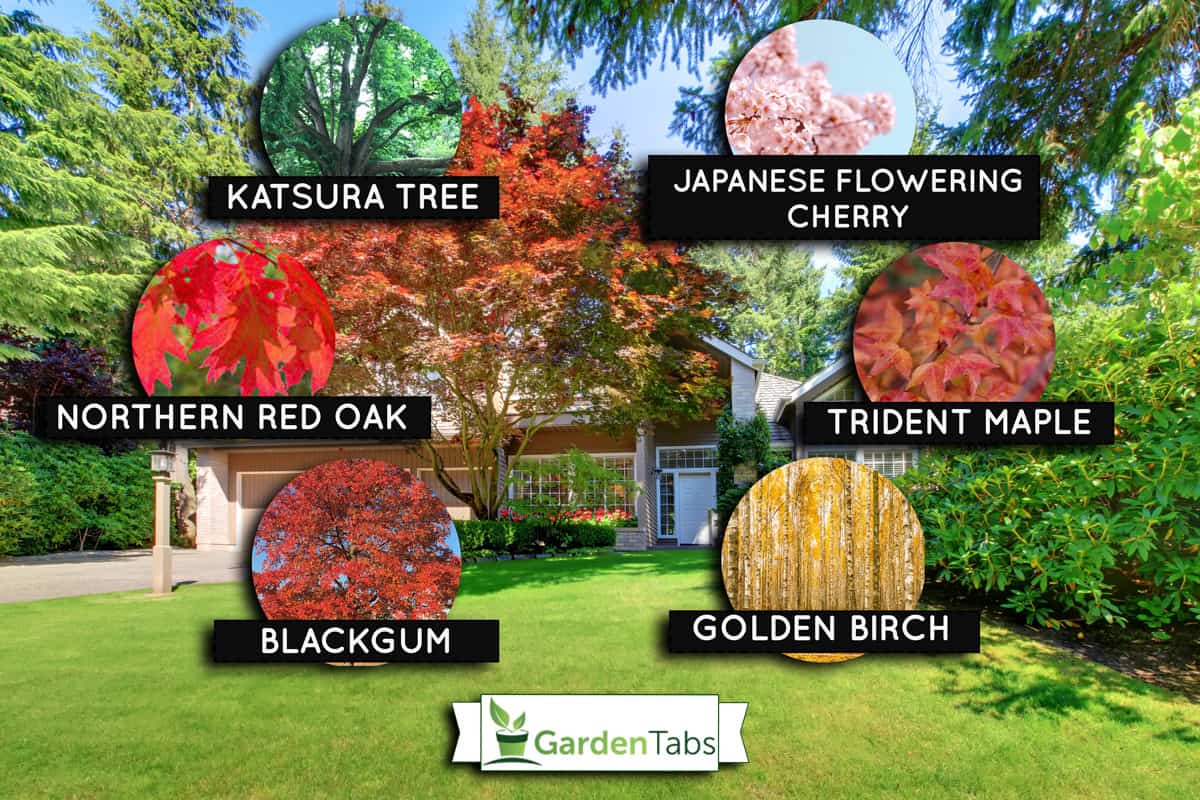
Our Zone 5 Shade Tree Suggestions
1. Trident Maple
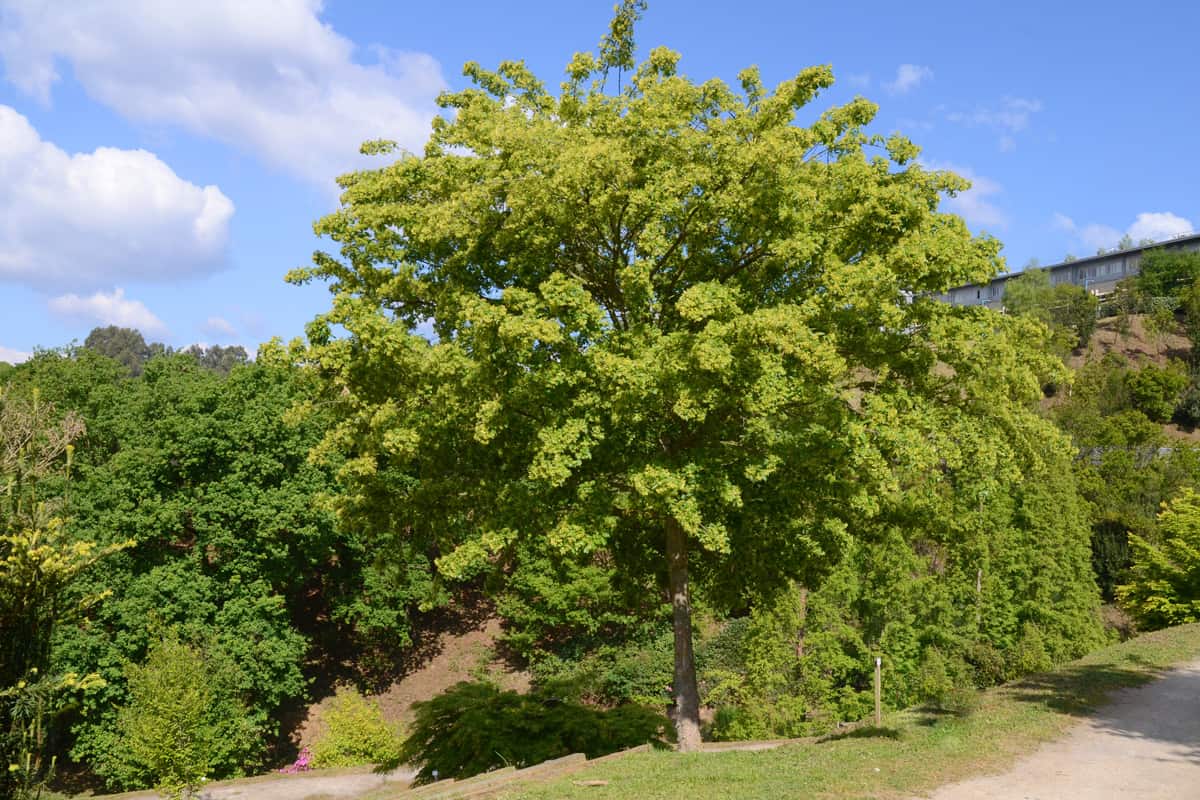
The Trident Maple is ideal for smaller yards. It has a mature height of between 20 and 35 feet with a spread between 20 and 30 feet. The Trident Maple has a medium growth rate. They tend to grow less than two feet each year.
This deciduous tree has small, green flowers in the spring. It produces brown and green samara-type fruit and yellow, orange, and red leaves in the fall. The bark is also of interest.
The gray bark will peel, which reveals the orange-brown bark underneath.
These trees are suited for USDA Hardiness Zones 5a-9b. They should be grown in full sun with well-drained, slightly acidic soil. However, this tree is tolerant of a variety of soil conditions.
Your trident maple can withstand moist, wet, and dry soil. It can also tolerate pollution, salt, and wind conditions.
2. Red Maple
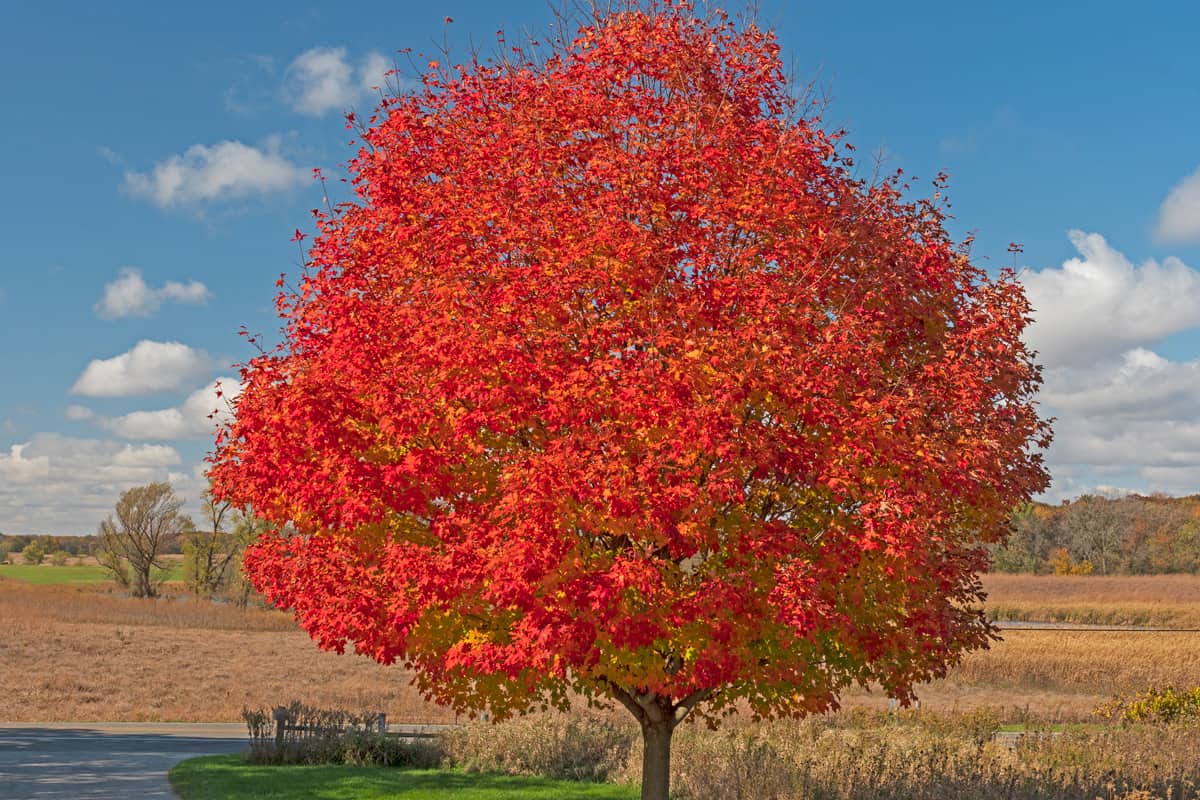
Red maple trees are large trees that occasionally reach as high as 120 feet tall. Although, you'll typically find them around 40 and 60 feet tall and 40 feet wide. This tree is a quick grower.
It can grow anywhere between 13 inches and over 24 inches each year, depending on the conditions.
These deciduous trees are of interest throughout the year. The leaves are showy and can appear in green, gold, and orange. They then change to red and gold in the fall months.
The fragrant flowers are red and bloom from winter to spring. An additional bonus is everything these trees attract. Bees, butterflies, moths, and small mammals can use the red maple.
The red maple is rated for USDA Hardiness Zones 2a-9b. It prefers locations in full sun with moist clay soil. Red maples can be grown in a variety of conditions, though.
These include partial shade, loamy or sandy soil, and occasional flooding and drought.
Another benefit of this tree is the number of challenges they resist. Red maples can withstand compacted soil, deer, fire, heat, pollution, and urban conditions.
Check out "What To Plant Under Maple Trees [Inc. Japanese Maple]" for some great tips!
3. Golden Birch
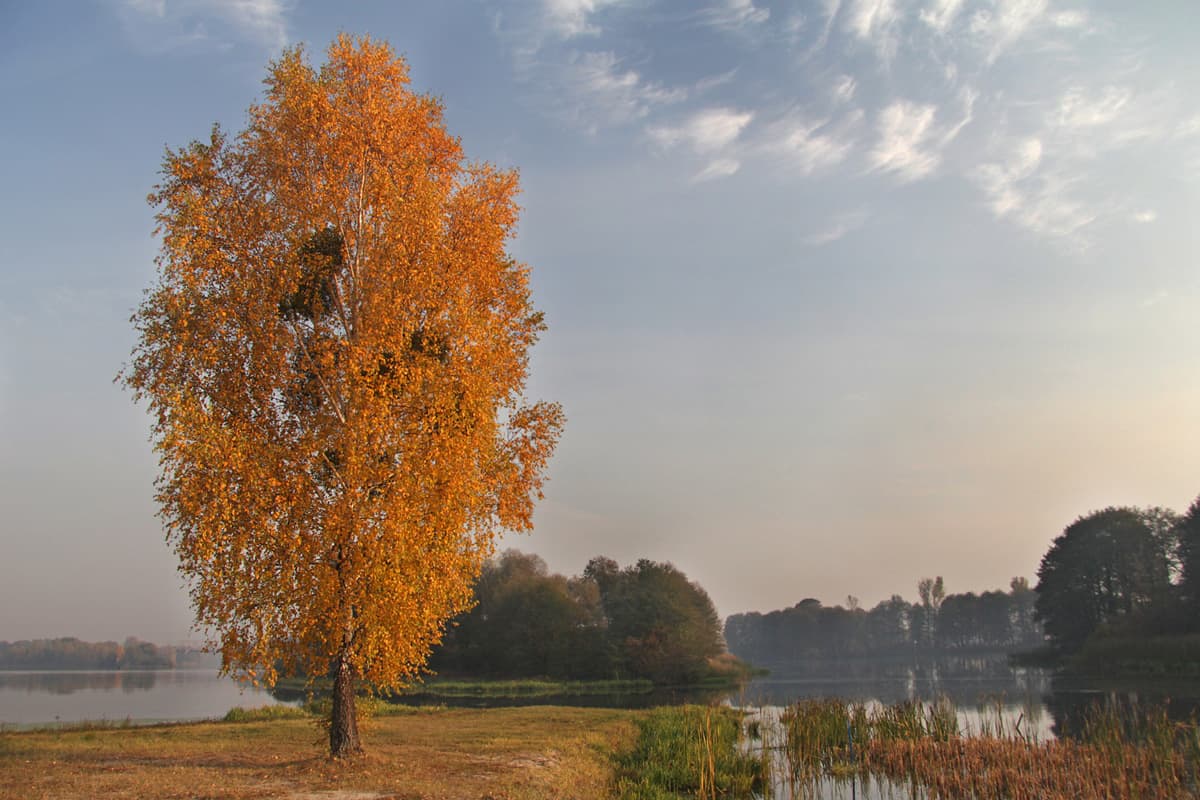
The golden birch tree typically grows between 70 and 80 feet tall and 60 and 80 feet wide. This is a slow-growing and high-maintenance tree.
Golden birches produce both male and female gold catkin flowers in the springtime.
In the summer, nut and samara fruit appear. In the fall, the leaves will turn a golden yellow. Finally, the bark is exfoliating. So, the light gray bark will peel to show the light brown bark underneath.
These trees are rated for USDA Hardiness Zones 3a-7b. You should provide your golden birch with the full sun each day. It also prefers moist but well-drained, acidic, loam soil.
4. Katsura Tree
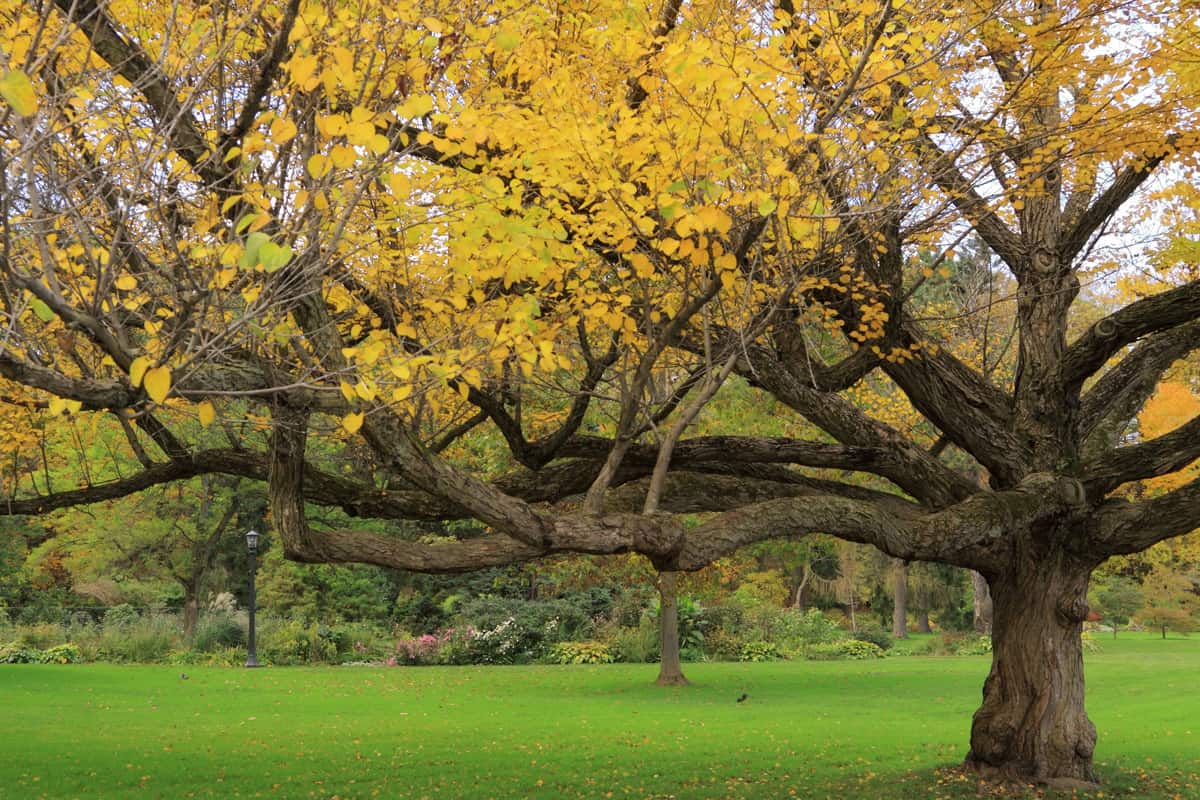
The Katsura tree, also known as the Japanese Judas Tree, is small to medium-sized. You can expect it to grow between 40 and 60 feet tall and 30 and 60 feet wide.
These trees bloom in the springtime. They produce green or red flowers, whether female or male. The leaves of the katsura tree are very showy. They are blue, yellow, green, and purple.
In the fall, they turn yellow and orange. They also produce green and brown fruits in the fall time.
Katsura trees are rated for USDA Hardiness Zones 4a-8b. They prefer rich, well-drained soil in full sun to part shade.
Check out this katsura tree on Amazon.
5. Blackgum
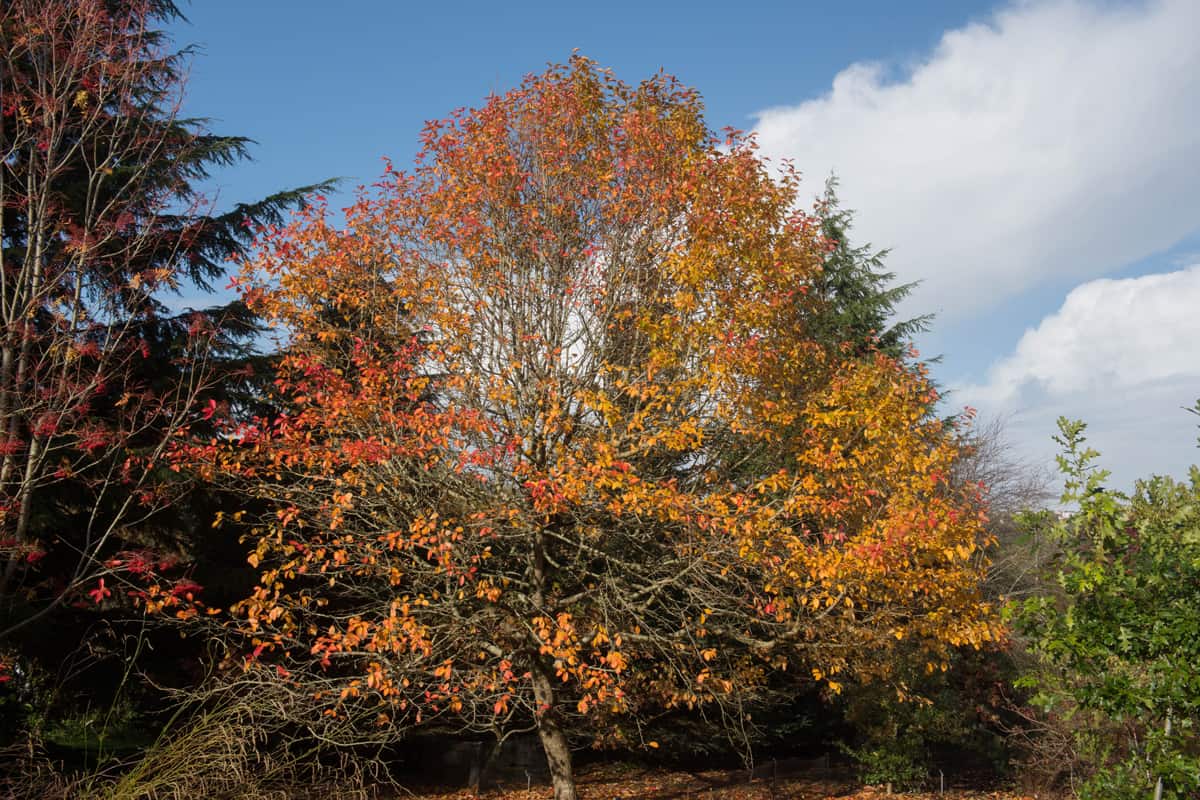
In cultivation, the blackgum or black tupelo tree can grow between 20 and 30 feet tall and between 20 and 35 feet wide. In their native habitats, these trees commonly reach between 50 and 80 feet tall.
This is a slow-growing tree. It will grow less than 24 inches each year.
Blackgums produce yellow, green, or white flowers from April until June. The flowers are small, yet they provide nectar for bees and other pollinators. The big wildlife provider is the blue and black fruits from August to October.
The egg-shaped fruits are present on female trees and are eaten by songbirds, turkeys, black bears, foxes, raccoons, and possums. Humans have also enjoyed raw or cooked berries, typically as a preserve.
This plant is also beneficial for reptiles. The hollows in the wood provide safety for snakes, frogs, and even bats. The leaves of this tree provide beautiful pops of color throughout the year.
They are typically yellow, green, orange, and purple. Then, as the leaves change, you'll see them in yellow, orange, purple, and red.
The bark is light gray, and as the tree ages, there will be hard, black pieces of bark.
Blackgum trees are suited for USDA Hardiness Zones 3a-9b. It's best to give these plants full sun and plant them in well-drained, acidic soil.
These trees are slightly susceptible to leaf spots, canker, and rust. However, it is resistant to a lot of troubles. Once established, blackgums are resistant to deer, drought, heat, salt, wind, fire, and wet soil.
6. Japanese Flowering Cherry
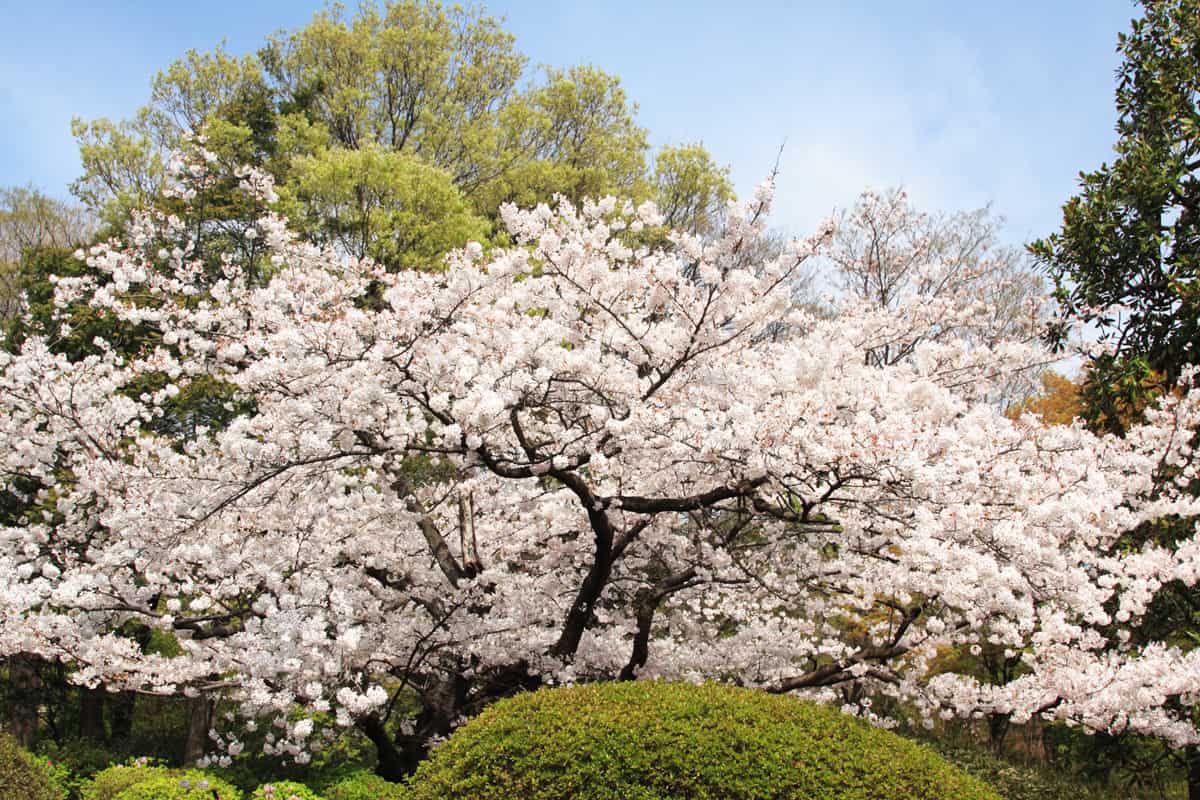
The Japanese Flowering Cherry or Yoshino Cherry is an excellent shade tree for smaller spaces. These deciduous trees have a mature height of between 30 and 50 feet with a spread between 20 and 50 feet.
You won't have to wait long for this tree to begin providing shade. It grows between 13 and 24 inches each year.
The leaves on this tree are green before they turn shades of yellow and gold in the fall months. The glossy bark with lenticels or raised pores is a stunning sight through winter.
Come spring, the Japanese Flowering Cherry produces pink and white flowers. They are fragrant with four to five petals and typically bloom for around two weeks.
Finally, the black fruits are present in the summer months.
This tree is rated for USDA Hardiness Zones 5a-8b. Japanese Flowering Cherry does best in moist soils. Otherwise, this is a very adaptive tree.
It can grow in clay, loam, sand, and shallow rocky soil.
Unfortunately, the Japanese Flowering Cherry does face a few problems. These trees are susceptible to viral and fungal diseases and are commonly damaged by deer. It can also be messy and an issue for pets.
7. Northern Red Oak

The northern red oak has a mature height of between 60 and 90 feet. It grows quickly in the first ten years, often over 24 inches yearly.
These trees have green and gray leaves that turn red and brown in the fall.
The northern red oak produces edible acorns in the fall. These nuts benefit people and small mammals, but it can take 40 years before a large amount is made.
Northern red oaks are suited for USDA Hardiness Zones 4a-8b. It grows well in acidic to neutral soil pH. In addition, these oaks can tolerate loamy, sandy, and clay soil types.
Once established, these trees resist fire, pollution, drought, and black walnut. Unfortunately, they are susceptible to oak wilt and chlorosis.
Northern red oaks are also slightly poisonous for horses and people.
Curious about how much water these trees need? Look at "How Much Water Does An Oak Tree Need?"
To Wrap Things Up
There are many great options for shade trees for Zone 5! These trees provide even more than just shade. You can see beautiful colors with different flowers and fruits throughout the year.
Before selecting a plant, ensure it will tolerate the soil and space you can give it. Now that you've made it here, thanks for reading!




